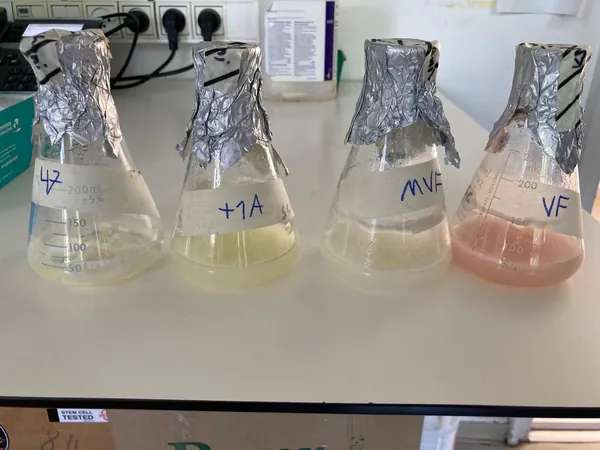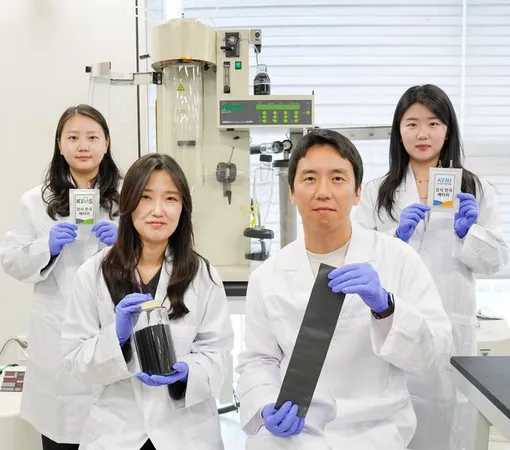
Revolutionary Method Unveils Hidden Signals in Water to Detect Tomato Plant Diseases Early!
2025-04-02
Author: John Tan
Introduction
Researchers at the Hebrew University of Jerusalem have made a groundbreaking discovery that could change the landscape of agricultural disease management. Their innovative approach allows for the early detection of Fusarium wilt in tomato plants by closely monitoring subtle alterations in the plants' water usage, long before visual symptoms make an appearance.
Significance of Water-Relation Traits
This significant advancement hinges on the measurement of water-relation traits, particularly transpiration rates. By employing this sensitive and quantitative methodology, breeders and researchers can now gauge disease severity, pathogen virulence, and plant susceptibility with unprecedented precision. This could dramatically reduce crop losses and promote sustainable farming practices.
Research Background
The study, led by Ph.D. student Shani Friedman (Goldfarb) under the mentorship of Prof. Menachem Moshelion of the Institute of Plant Sciences and Genetics in Agriculture at the Hebrew University, illustrates a paradigm shift in disease detection techniques.
Unlike traditional methods that depend heavily on visible signs of disease, often leading to late intervention when damage is already severe, this research pioneers a more proactive approach.
Implications for Plant Science
The implications for the field of plant science are monumental. It not only arms breeders and scientists with an effective means to enhance early disease identification but also facilitates a deeper understanding of plant-pathogen dynamics. The findings of this research were published in the prestigious journal Plant Disease.
Understanding Fusarium Wilt
Fusarium wilt, instigated by the soil-borne fungus Fusarium oxysporum f. sp. lycopersici, is notorious for wreaking havoc on tomato crops globally, resulting in significant economic ramifications. The typical methods of spotting this disease rely heavily on visual inspections, a practice fraught with subjectivity and potential inaccuracies.
Innovative Monitoring Techniques
However, this new research leverages high-throughput physiological phenotyping systems to monitor transpiration levels continuously. The team utilized cutting-edge lysimeter technology to track changes in transpiration rates and plant biomass within controlled greenhouse environments. Intriguingly, they noted declines in transpiration rates occurring days to weeks prior to the first signs of any visual symptoms.
Research Insights
"This research illustrates that physiological traits related to water use can serve as trustworthy early indicators of Fusarium infection," stated Shani Friedman. "We were capable of quantitatively assessing the plants' responses to the pathogen long before they displayed the traditional visible symptoms of disease."
Quantitative Benefits
The quantitative nature of this approach not only detects the onset of disease but also measures the virulence of the pathogens and the levels of plant susceptibility. Consequently, farmers and researchers gain access to crucial numeric data that delineates how severely a pathogen is impacting the crops and reveals how various tomato cultivars stand up against Fusarium wilt.
Broader Implications
Collaborator Dr. Shay Covo from the Department of Plant Pathology and Microbiology highlighted the broader implications of the study. "This quantitative model opens new avenues for exploring plant-pathogen interactions, allowing us to improve our understanding of how pathogens affect plants at the onset of disease."
Future Potential
Prof. Menachem Moshelion discussed the expansive potential of this methodology. "What we've developed here is not limited to tomatoes; it carries exciting possibilities for agriculture as a whole. Early detection through physiological monitoring could substantially decrease crop losses and improve sustainable agricultural strategies."
Conclusion
The versatility of this innovative methodology has been further showcased by its successful application to potato plants suffering from late blight, underscoring its potential to combat other critical plant diseases. As the agricultural world confronts increasing challenges from pathogens, this revolutionary technique offers a glimmer of hope, paving the way for healthier crops and more resilient farming practices in the future!



 Brasil (PT)
Brasil (PT)
 Canada (EN)
Canada (EN)
 Chile (ES)
Chile (ES)
 Česko (CS)
Česko (CS)
 대한민국 (KO)
대한민국 (KO)
 España (ES)
España (ES)
 France (FR)
France (FR)
 Hong Kong (EN)
Hong Kong (EN)
 Italia (IT)
Italia (IT)
 日本 (JA)
日本 (JA)
 Magyarország (HU)
Magyarország (HU)
 Norge (NO)
Norge (NO)
 Polska (PL)
Polska (PL)
 Schweiz (DE)
Schweiz (DE)
 Singapore (EN)
Singapore (EN)
 Sverige (SV)
Sverige (SV)
 Suomi (FI)
Suomi (FI)
 Türkiye (TR)
Türkiye (TR)
 الإمارات العربية المتحدة (AR)
الإمارات العربية المتحدة (AR)